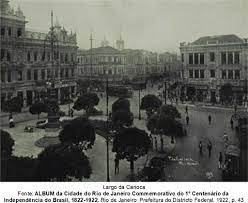RIO DE JANEIRO, BRAZIL – To mark the bicentennial of Brazil’s independence, an exhibition in Rio de Janeiro recalls the grand celebrations of 100 years ago. The 1922 event showed a country that was modern for its time and had a class that nowadays is only granted to Buenos Aires.
Argentines may have become poor, but culture and aesthetics are in their DNA. Still today.
Looking at Rio de Janeiro today, one can only wonder how this city could have fallen so low. It is a living reminder of what pure greed can do without an elite committed to beauty. And the loss of the capital status to Brasilia has added to the damage.
One hundred years ago, the celebration was grand. The pictures show the magnificent buildings specially constructed for the World’s Fair, one of Brazil’s most significant international events to date, attended by over 20 heads of state.
The celebration lasted 11 months and was planned two years in advance. Fourteen countries were represented with pavilions that attracted 3.5 million visitors. And right at the opening, a milestone: Brazil’s first radio broadcast – first with speeches, then with Carlos Gomes’ opera “O Guarani.”
Congress released 100 thousand ‘Contos de réis’ for the festivities, an exorbitant amount for the time. That same year, a severe drought in the northeast resulted in thousands of deaths.
President Epitácio Pessoa imposed a state of siege because of the military revolt in Copacabana, which became known as “The 18 of the Fortress.” And many families suffered from inflation.
“It’s interesting how we see some problems resurface, like the issue of hunger, the price of light, energy, if we think about the increase in the price of gasoline. So we see a country that on the one hand has modernized, but on the other hand, continues to have many social problems,” explains anthropologist Ana Teles da Silva.
In the magazines, however, the city of Rio de Janeiro was touted as a showcase for the nation, proud of its progress after World War I and its victory over several epidemics, such as the Spanish flu. When you learn how the Independence Centennial celebrations went, you can’t help but marvel.
“I’ve lived here in Rio de Janeiro all my life and never had any idea that this kind of architecture had been built for a commemoration. It gave me a sense of nostalgia for a time I didn’t live through, but a nostalgia for that era,” researcher and botanist Sarah Domingues Ricardo tells G1.
Castle Hill, where Rio’s settlement began, was destroyed to make way for the 1922 World’s Fair buildings. Today, only four of them remain. Among them are the Brazilian Academy of Literature headquarters and the National History Museum itself, where the exhibition was set up.
“We must know history in order not to repeat mistakes in the future; we must always remember and search. If we don’t know, we should go to museums and memory centers to remember and see what happened,” says Sarah Domingues.
With information from G1





